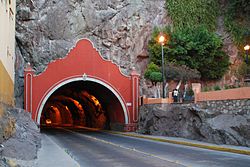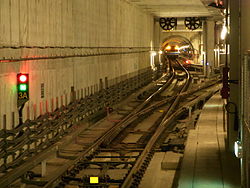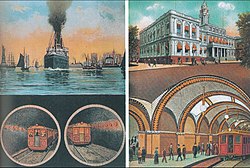Tunnel
A tunnel is an underground passage. Some tunnels are used for cars, and others are used for trains. Sometimes, a tunnel is used for movement of ships. Some tunnels are built for communication cables and some are built for electricity cables. Other tunnels are built for animals.[1]

| Wikimedia Commons has media related to Lua error in Module:Commons_link at line 62: attempt to index field 'wikibase' (a nil value).. |
Tunnels are dug in different kinds of grounds, from soft sand to hard rock. The way of digging is chosen by the type of ground. There are two additional ways of digging: quarry and 'cut and cover'. In quarry, the tunnel path is drilled in a horizontal way.
This system requires a deep tunnel that's built in a firm rock. In the 'cut and cover' system, a tunnel is dug in the ground and then afterwards, a roof is built above the tunnel. This system fits tunnels that are close to the ground like road tunnels and infrastructure.
Building tunnels is a large civil engineering project that could cost very high sums of money. The planning and building of a long tunnel may take many years.
The Channel Tunnel between France and England is one of the longest tunnels in the world. It is 50 kilometers long. The longest tunnel in the world, the Gotthard Base Tunnel, is being dug in Switzerland.
Reasons to build a tunnel
- A subway is based on a network of tunnels that are dug underground so the trains will not disturb and will not be disturbed by the local transport.
- On the path of a railroad track or a road a tunnel is dug when the lane encounters an obstacle such as a mountain to avoid bypassing the obstacle.
- A tunnel is built sometimes to overcome a water obstacle as a replacement for building a bridge above it.
- A tunnel is built to connect between military posts so the movement between them will not be visible for the enemy.
- A tunnel is built for infrastructure like electricity cables, water, communication and sewerage to avoid damage and disruption above ground.
- Some tunnels are used by prisoners to escape jail.
- Sometimes tunnels are used by criminals to do a bank robbery (e.g. in Brazil, Summer 2005).
Cut-and-cover
Cut-and-cover is a simple way of making hollow tunnels where a trench is hollowed out and roofed over with an overhead support system strong enough to carry the load of what is to be built above the tunnel.[2] Two basic forms of cut-and-cover tunneling are available:
- Bottom-up method: A trench is hollowed out, with ground support when needed, and the tunnel is built in it. In earliest days bricks were used. The trench is then carefully filled and the surface is reinstated.
- Top-down method: Side support walls and capping beams are made from ground level by such methods as slurry walling or neighbouring bored piling. Only a hollowed out excavation is needed to construct the tunnel roof using beams or in situ concrete sitting on the walls. The surface is then remade except for access openings. This allows early recreation of roadways, services, and other surface features. Excavation then takes place under the permanent tunnel roof, and the base slab is made.
TunnelCut-and-cover Media
Tunnel in Col du Galibier, France
Tunnel in Fort de Mutzig, France
Decorated portal to a road tunnel in Guanajuato, Mexico
Utility tunnel for heating pipes between Rigshospitalet and Amagerværket in Copenhagen, Denmark
Tunnel on the Taipei Metro in Taiwan
Southern portal of the 421 m long (1,381 ft) Chirk canal tunnel, Wales
Joralemon Street Tunnel on 1913 postcard, part of the New York City Subway system
The Harbor Tunnel in Baltimore, USA, which carries I-895, serves as an example of a water-crossing tunnel built instead of a bridge.
Notes
- ↑ Images for tunnels
- ↑ Ellis 2015, p. 118.
Books
- Ellis, Iain W (2015). Ellis' British Railway Engineering Encyclopaedia (3rd Revised ed.). Lulu.com. ISBN 978-1-326-01063-8.
- Railway Tunnels in Queensland by Brian Webber, 1997, ISBN 0-909937-33-8.
- Sullivan, Walter. Progress In Technology Revives Interest In Great Tunnels, New York Times, 24 June 1986. Retrieved 15 August 2010.










